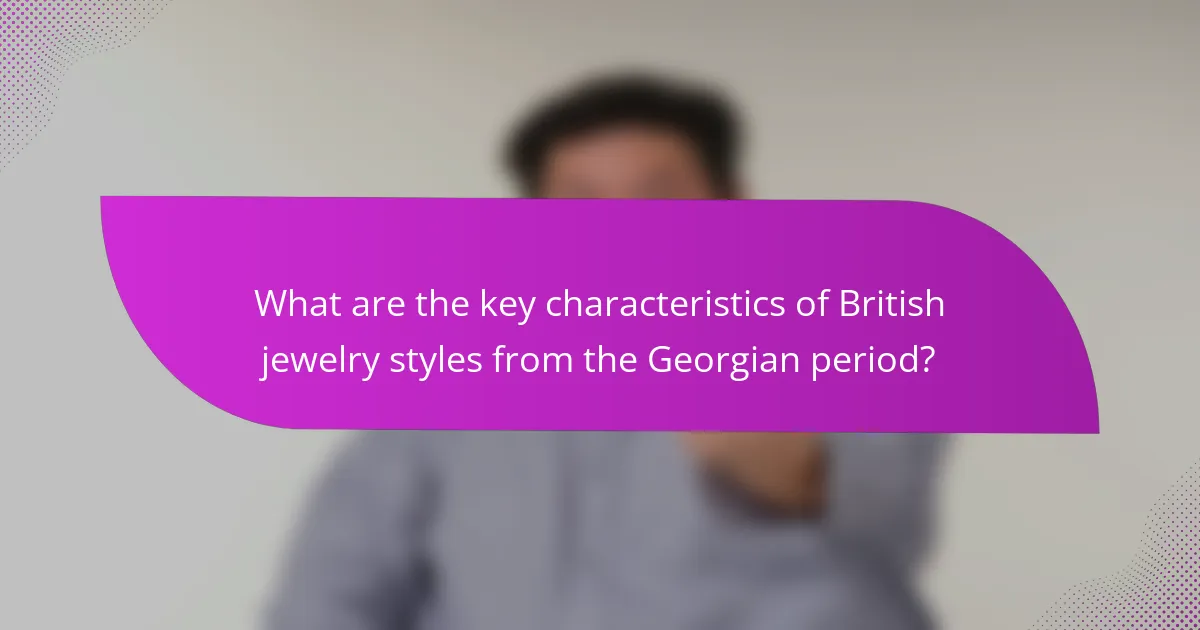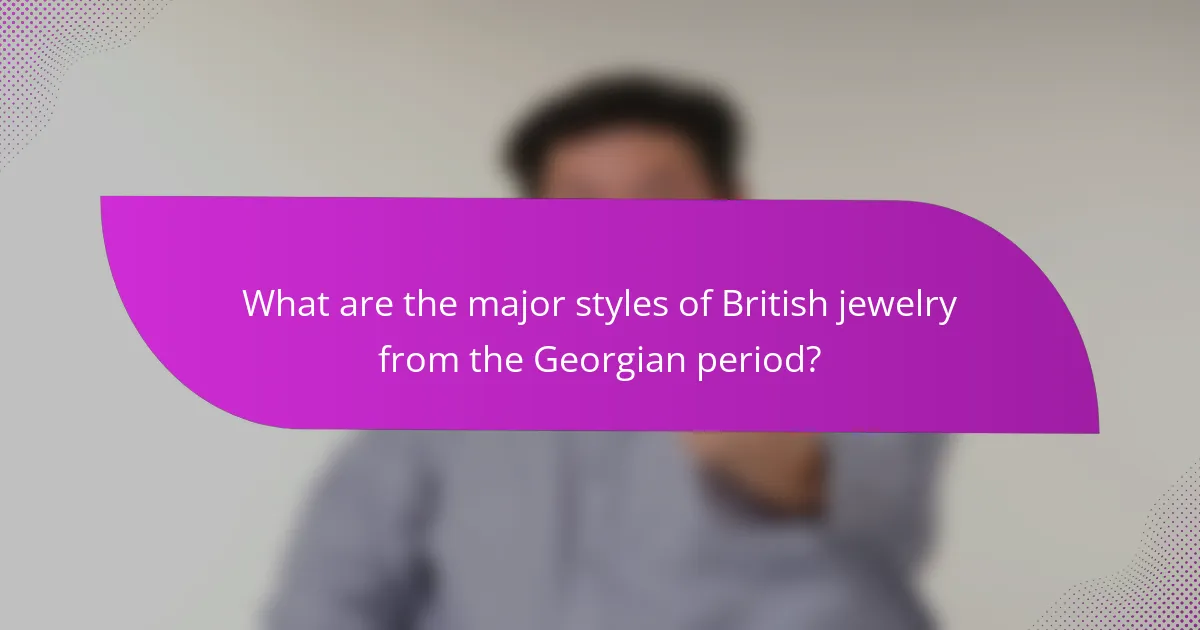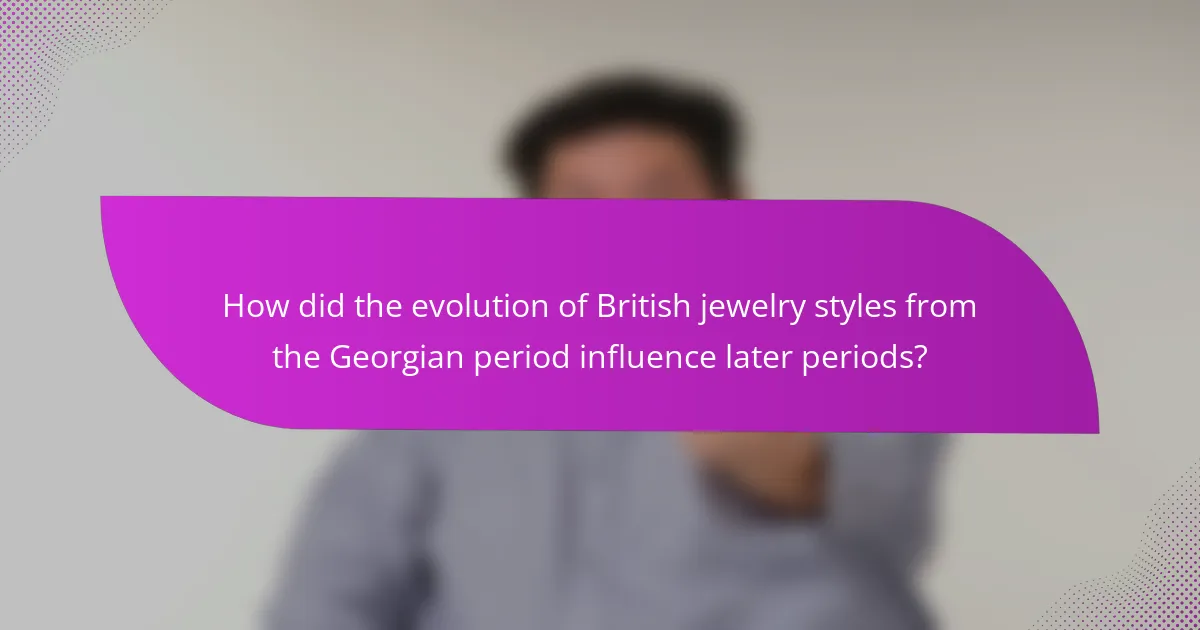The article explores the evolution of British jewelry styles from the Georgian period, which spans from 1714 to 1830. It highlights the intricate designs and craftsmanship characteristic of this era, including the use of natural motifs and gemstones like diamonds, emeralds, and rubies. Key styles discussed include Neoclassical, Romantic, and Gothic Revival, each reflecting different artistic movements and themes. The article also examines the significance of mourning jewelry and the lasting influence of Georgian jewelry on subsequent periods, particularly in terms of personalization and quality standards.

What are the key characteristics of British jewelry styles from the Georgian period?
British jewelry styles from the Georgian period are characterized by intricate designs, use of natural motifs, and a focus on craftsmanship. Jewelry from this era often featured gemstones such as diamonds, emeralds, and rubies set in gold or silver. The styles included elaborate brooches, necklaces, and earrings, often adorned with floral and scroll patterns. Additionally, the use of enamel work and cameos was prominent, showcasing artistic skill. This period also saw the rise of mourning jewelry, which incorporated hair or portraits of the deceased. Overall, Georgian jewelry reflects the elegance and opulence of the time, with a strong emphasis on personal expression and artistry.
How did the Georgian period influence jewelry design in Britain?
The Georgian period significantly influenced jewelry design in Britain through its emphasis on craftsmanship and intricate detail. Jewelry from this era often featured elaborate motifs, including floral and naturalistic designs. The use of gemstones became more prominent, with an increased focus on diamonds, emeralds, and sapphires.
Additionally, advancements in techniques such as enameling and the introduction of new settings enhanced the aesthetic appeal. The period also saw the rise of personalized jewelry, including lockets and mourning pieces. These trends reflected broader societal changes, such as the growing middle class and the romantic ideals of the time.
The influence of the Georgian period is still evident in modern jewelry, showcasing its lasting impact on design principles.
What materials were commonly used in Georgian jewelry?
Georgian jewelry commonly used materials such as gold, silver, and gemstones. Gold was favored for its malleability and luster. Silver provided a more affordable option with a similar aesthetic appeal. Gemstones like diamonds, emeralds, and rubies were also prevalent. Pearls were highly sought after for their elegance. Enamel work was frequently used to add color and detail. Additionally, materials like garnets and topaz were popular choices in various designs. These materials reflect the craftsmanship and luxury of the Georgian period.
How did craftsmanship evolve during the Georgian period?
Craftsmanship evolved significantly during the Georgian period. This era, spanning from 1714 to 1830, saw advancements in techniques and materials. Artisans began to focus on individual craftsmanship rather than mass production. The introduction of new tools enhanced precision in jewelry making. Additionally, the use of gemstones became more prevalent. Techniques such as enameling and goldsmithing were refined, allowing for intricate designs. The influence of neoclassicism also shaped aesthetic choices in jewelry. Overall, craftsmanship during this time reflected a blend of artistry and emerging industrial practices.
What cultural factors shaped British jewelry styles in the Georgian period?
Cultural factors that shaped British jewelry styles in the Georgian period include social status, artistic movements, and technological advancements. The period, spanning from 1714 to 1830, emphasized the rise of the middle class. This social change increased demand for decorative jewelry among a broader audience.
Artistic movements such as Neoclassicism influenced design elements. Jewelry featured classical motifs, including cameos and intaglios. The Romantic movement also played a role, introducing sentimental pieces.
Technological advancements in metalworking and gem cutting improved jewelry quality and accessibility. The introduction of new materials, such as paste stones, allowed for more elaborate designs.
Additionally, the influence of the Grand Tour exposed British society to international styles. This exposure led to the incorporation of exotic designs and materials. Overall, these cultural factors collectively defined the distinct jewelry styles of the Georgian era.
How did social status affect jewelry choices in the Georgian era?
Social status significantly influenced jewelry choices in the Georgian era. The upper class favored extravagant pieces made from precious materials. They adorned themselves with diamonds, emeralds, and gold. These choices signified wealth and power. In contrast, the middle and lower classes opted for simpler designs. They often used less expensive materials like paste and base metals. Jewelry for them was more about personal expression than status display. This disparity in choices reflected the strict social hierarchy of the time. Additionally, jewelry styles varied with social events, often aligning with one’s status. The use of specific motifs and craftsmanship also indicated one’s social standing.
What role did fashion trends play in the evolution of Georgian jewelry?
Fashion trends significantly influenced the evolution of Georgian jewelry. During the Georgian period, which spanned from 1714 to 1830, jewelry styles reflected contemporary fashion aesthetics. The rise of neoclassicism led to the popularity of classical motifs in jewelry, such as cameos and intaglios.
Additionally, the increase in wealth among the middle class created demand for more ornate and diverse jewelry pieces. This period saw the introduction of new materials, including paste and colored gemstones, aligning with prevailing fashion trends.
The influence of royal figures, like Queen Charlotte, also shaped jewelry trends, as their styles were emulated by the public. Furthermore, the shift towards romanticism in the late Georgian period introduced sentimental jewelry, featuring locks of hair and personalized pieces.
Overall, fashion trends acted as a driving force in the design, materials, and symbolism of Georgian jewelry, reflecting societal changes and aesthetic preferences of the time.

What are the major styles of British jewelry from the Georgian period?
The major styles of British jewelry from the Georgian period include Neoclassical, Romantic, and Gothic Revival. Neoclassical jewelry featured classical themes and motifs. It often incorporated cameos, intaglios, and classical figures. Romantic jewelry embraced sentimental themes and nature-inspired designs. It frequently used floral motifs and heart shapes. Gothic Revival jewelry drew inspiration from medieval designs. It included intricate metalwork and the use of dark gemstones. Each style reflected the artistic movements of its time. The Georgian period spanned from 1714 to 1830, marking significant changes in jewelry design.
What distinguishes the early Georgian jewelry style?
The early Georgian jewelry style is distinguished by its intricate designs and use of natural motifs. This period, spanning from 1714 to 1760, showcased craftsmanship that emphasized elegance and artistry. Jewelers often incorporated materials such as gold, silver, and gemstones. Popular techniques included enameling and the use of paste stones. The style frequently featured floral and scroll patterns, reflecting the Rococo influence. Additionally, the early Georgian era marked the rise of the parure, a matching set of jewelry. This era also saw the popularity of cameos and intaglios, which added depth to the designs. Overall, the early Georgian jewelry style is characterized by its ornate detail and romantic themes.
What motifs and designs were popular in early Georgian jewelry?
Early Georgian jewelry featured motifs such as floral designs, ribbons, and scrollwork. These designs were often characterized by intricate detailing and elegance. Popular materials included gold and silver, frequently adorned with gemstones. The use of cameos and intaglios was also notable during this period. Additionally, motifs inspired by nature, such as leaves and birds, were commonly incorporated. The emphasis on symmetry and balance defined the aesthetic of early Georgian jewelry. This style reflects the broader artistic movements of the time, including neoclassicism.
How did the early Georgian style reflect societal values?
The early Georgian style reflected societal values through its emphasis on symmetry and classical influences. This style showcased a preference for order and balance, mirroring the Enlightenment ideals of reason and rationality. Decorative arts during this period often featured motifs inspired by nature and mythology, indicating a growing appreciation for both human creativity and the natural world.
The use of high-quality materials, such as gold and gemstones, illustrated the wealth and status of patrons. Jewelry pieces often included intricate designs that demonstrated craftsmanship and artistry, highlighting the importance of skill in society. Additionally, the rise of the middle class during this time led to a demand for accessible yet elegant designs, reflecting changing social dynamics.
Overall, the early Georgian style served as a visual representation of the values of elegance, reason, and social aspiration prevalent in society during that era.
What are the characteristics of the late Georgian jewelry style?
The late Georgian jewelry style is characterized by intricate designs and the use of various materials. This period, spanning from the late 18th century to the early 19th century, showcases craftsmanship and artistry. Jewelry pieces often feature motifs inspired by nature, including floral and foliate designs. Gemstones such as diamonds, garnets, and amethysts were commonly used. Additionally, the use of gold and silver in elaborate settings is prominent. The style also reflects a shift towards romanticism, with softer shapes and more delicate features. Overall, late Georgian jewelry is distinguished by its elegance and attention to detail.
How did the late Georgian style incorporate new materials and techniques?
The late Georgian style incorporated new materials and techniques through the use of innovative alloys and gemstone settings. Jewelers began using gold alloys that allowed for more intricate designs. This period also saw the introduction of new techniques like enameling and the use of paste gems. Enameling added color and detail to pieces, enhancing their visual appeal. The use of paste gems provided an affordable alternative to natural stones, making jewelry more accessible. Additionally, advancements in metalworking techniques allowed for finer detailing and more complex structures. These changes reflected broader trends in craftsmanship and aesthetic preferences of the time.
What are some notable pieces from the late Georgian period?
Notable pieces from the late Georgian period include the “Gothic Revival” jewelry and “Sentimental” pieces. Gothic Revival jewelry features intricate designs inspired by medieval art. Sentimental pieces often incorporate hair or lockets with portraits. These styles reflect personal connections and emotional significance. The late Georgian period also saw the use of materials like gold, silver, and gemstones. Notable jewelers of the time include Garrard and Rundell. Their craftsmanship set high standards for future jewelry design. The late Georgian period marked a transition to more elaborate and expressive jewelry forms.

How did the evolution of British jewelry styles from the Georgian period influence later periods?
The evolution of British jewelry styles from the Georgian period set foundational trends for later periods. Georgian jewelry emphasized intricate designs and craftsmanship. It often featured motifs inspired by nature, such as flowers and leaves. The use of colored gemstones became prominent during this era. This focus on personalization influenced Victorian jewelry, which incorporated sentimental themes. Additionally, the Georgian period’s use of gold as a primary metal continued into the Edwardian era. The craftsmanship established during the Georgian period also led to a higher standard of quality in subsequent styles. Overall, the Georgian period laid the groundwork for the aesthetic and technical advancements in British jewelry that followed.
What are the connections between Georgian jewelry and Victorian styles?
Georgian jewelry and Victorian styles share aesthetic and thematic connections. Both periods emphasize intricate craftsmanship and ornate designs. Georgian jewelry features elaborate motifs, often inspired by nature and classical themes. Similarly, Victorian jewelry incorporates romantic elements, reflecting the sentiments of the era.
The use of gemstones is notable in both styles. Georgian pieces often utilized colorful stones like garnets and amethysts. Victorian jewelry expanded this palette, introducing diamonds and pearls prominently.
Additionally, both styles employed techniques like enamel work and filigree. These techniques enhanced the visual appeal and complexity of the pieces.
Cultural influences also connect the two periods. The Georgian era laid the groundwork for Victorian romanticism. This connection is evident in the sentimental motifs, such as hearts and flowers, prevalent in both styles.
Overall, the evolution from Georgian to Victorian jewelry reflects a continuity in design principles and emotional expression.
How did Georgian influences manifest in Victorian jewelry design?
Georgian influences significantly shaped Victorian jewelry design. The use of intricate motifs and nature-inspired themes from the Georgian era continued into Victorian pieces. Popular elements included floral designs, leaves, and scrollwork. Additionally, the technique of using gemstones in a variety of cuts and settings persisted. The Victorian era also embraced the Georgian love for sentimental jewelry, such as lockets and mourning pieces. Furthermore, the craftsmanship and attention to detail from the Georgian period were evident in Victorian jewelry. Overall, the aesthetic principles and emotional significance of Georgian jewelry laid the foundation for Victorian styles.
What innovations from the Georgian period continued into the Victorian era?
The innovations from the Georgian period that continued into the Victorian era include advancements in jewelry design and manufacturing techniques. The use of intricate metalwork and detailed craftsmanship persisted. Techniques such as enameling and gemstone setting remained popular. Additionally, the emphasis on personal expression through jewelry continued to grow. The Romantic movement influenced the sentimental value placed on jewelry. Mourning jewelry, popularized in the Georgian period, was also embraced during the Victorian era. Overall, these innovations shaped the evolution of British jewelry styles significantly.
What lessons can be learned from the evolution of British jewelry styles from the Georgian period?
The evolution of British jewelry styles from the Georgian period teaches us about changing aesthetics and cultural influences. Jewelry from this era reflects the transition from ornate designs to more simplified forms. The use of materials varied significantly, with an emphasis on gemstones and intricate metalwork. Social status and personal expression were key factors driving jewelry choices. Additionally, the influence of historical events, such as the Industrial Revolution, led to innovations in production techniques. These changes highlight the relationship between art, society, and technology in shaping jewelry styles. The Georgian period also emphasizes the importance of craftsmanship and individual artistry in jewelry design.
How can modern jewelry designers draw inspiration from Georgian styles?
Modern jewelry designers can draw inspiration from Georgian styles by incorporating intricate designs and ornate details. Georgian jewelry is characterized by its use of natural motifs, such as flowers and leaves. Designers can use similar themes to create contemporary pieces that resonate with historical elegance.
The use of colored gemstones was prominent in Georgian jewelry. Modern designers can adopt this practice to enhance the vibrancy of their collections. Georgian pieces often featured intricate metalwork, including filigree and granulation. This technique can be reinterpreted in modern designs to add depth and texture.
Additionally, the asymmetry found in Georgian jewelry can inspire contemporary designers to create unique, eye-catching pieces. Georgian styles often included the use of symbolism, such as hearts or crosses. Modern designers can integrate meaningful symbols to connect with consumers on a personal level.
Finally, the craftsmanship of Georgian jewelry serves as a benchmark for quality. Emphasizing artisanal techniques can elevate modern designs and appeal to a market that values craftsmanship.
What are some best practices for incorporating historical elements into contemporary jewelry design?
Incorporating historical elements into contemporary jewelry design involves blending traditional aesthetics with modern techniques. Designers should research historical styles to understand their significance and characteristics. Utilizing authentic materials common in historical pieces can enhance authenticity. Combining vintage techniques with contemporary methods can create unique designs. Incorporating symbolic motifs from historical periods can add depth to the pieces. Additionally, adapting historical designs to suit modern tastes ensures relevance. Collaborating with historians can provide insights into the cultural context of the designs. Finally, showcasing the historical inspiration in marketing can attract customers interested in heritage.
The main entity of this article is British jewelry styles from the Georgian period. The article explores the key characteristics of Georgian jewelry, including intricate designs, natural motifs, and the use of gemstones such as diamonds and emeralds. It discusses how craftsmanship evolved during this era, influenced by cultural factors like social status and artistic movements. Additionally, the article highlights the major styles of Georgian jewelry, notable pieces, and the lasting impact of these designs on later periods, particularly the Victorian era. Overall, it provides a comprehensive overview of the aesthetic and technical advancements in British jewelry during the Georgian period.
